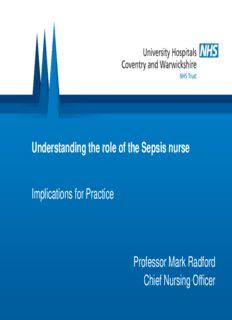
Understanding the role of the Sepsis nurse Implications for Practice Professor Mark Radford Chief PDF
Preview Understanding the role of the Sepsis nurse Implications for Practice Professor Mark Radford Chief
Understanding the role of the Sepsis nurse Implications for Practice Professor Mark Radford Chief Nursing Officer UHCW • 1400 beds – Two sites • Regional centre – MTC, Cardiac, Neuro, Transplant • Teaching hospital with Warwick Medical School • £525m • Circa 8100 staff – 600 Consultants – 2800 Nursing staff UHCW Vital Stats • Emergencies 185,000 • Surgeries 45,000 • Outpatients 577,548 • Admissions 138,588 • Babies born 6,031 The problem Sepsis Nurse Practitioners Methodology • Three Hospitals • Ethnography • District • Peripheral membership • 500 bed DGH role. • Urban • Artefacts • 1000+ bed inner city teaching • Process trust • Metropolitan • 29 ANP, 49 Drs (7 Teams) • 1000+ bed University Teaching Trust • Observation (150 hours) • Interviews 21 (15 hours) • Artefacts (99 Documents) Data Management Observation Session • 25 - 40 hours depending upon cohort Interviews • 5000 word narrative per 4 hours observation • 35 – 60 mins • Up to 40,000 words per cohort • 3-5000 words per transcript • 3 – 8 interviews Observation Review Review Interview Changed relationship • Primarily between Consultant and Junior • Service drivers and target culture of NHS • Societal position of medicine • Changes to the training of Junior Doctors • Impact on Nursing • Development of the ANP role • Expectation transfer from Junior Doctor to ANP Drivers for Change Medical & Nursing ‘in the early '80s when I qualified there was already push for change and that the nurses were beginning to say there's more to this than just bed pans • Nursing Changes …….. the nursing structure in the '70s • Medical Changes and '80s was still very rigid .......I think, a lot of intelligent nurses began to ask • Experience questions and when people start questioning the structure begin to • Service Delivery models break down.’ Consultant Surgeon, Interview
Description: